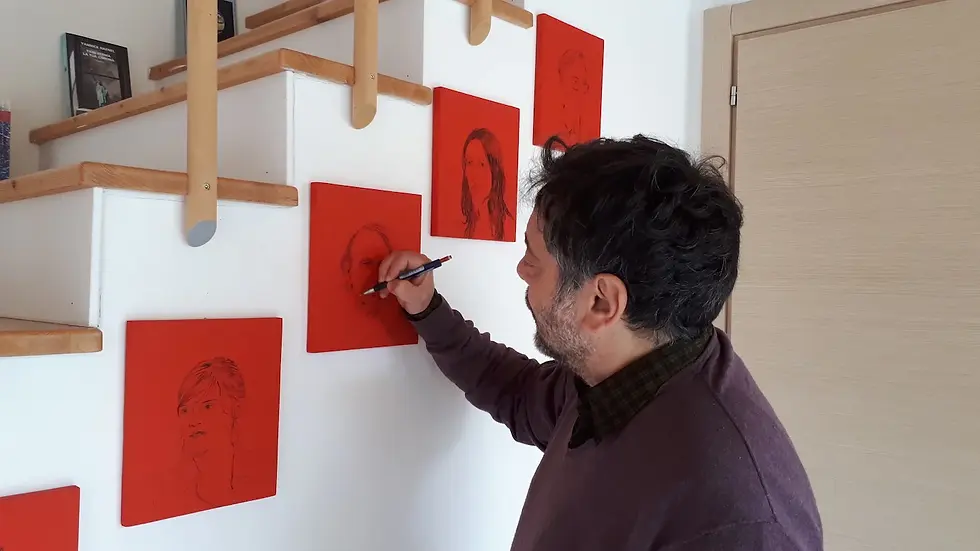Add paragraph text. Click “Edit Text” to update the font, size and more. To change and reuse text themes, go to Site Styles.

Add paragraph text. Click “Edit Text” to update the font, size and more. To change and reuse text themes, go to Site Styles.
Add paragraph text. Click “Edit Text” to update the font, size and more. To change and reuse text themes, go to Site Styles.
Add paragraph text. Click “Edit Text” to update the font, size and more. To change and reuse text themes, go to Site Styles.
Futuro Antico. Interview with Tommaso Pincio
10 ott 2023
Ludovico Pratesi
His novels and paintings are portraits, his vision of tomorrow has the contours of science fiction. Interview with Tommaso Pincio for Futuro Antico

What are your inspirational references in art?
The main reference, almost a beacon in the night, is the fixed image that appears on my Twitter or X profile, or whatever that social media is called now. It shows a white, tattered T-shirt with the words “til death, we do art.” It does indeed sound more like a principle, a declaration of intent, I realize. However, references change over time, depending on age and circumstances, and they are not necessarily always artistic.
What is the project that best represents you? Can you tell us about its genesis?
For years, I have been thinking about cataloging the paintings that appear in pornographic films, often set in living rooms, salons, or bedrooms where, above the sofa or bed where the lovers perform, there is indeed a painting or something decorative, even if it's just a simple poster. The inventory should lead to an exhibition or a catalog, an irreverent reinterpretation of Aby Warburg's Mnemosyne Atlas, so to speak. I have selected a few images, but for reasons that are easy to guess, I have never been able to work on it seriously. I fear it will remain an unrealized project, and with that, I come to the point. I don’t think this hypothetical atlas particularly represents me; perhaps it doesn’t represent me at all, except for its likely fate of incompleteness. I am captivated by unrealized or unrealizable ideas.

What importance does Genius Loci hold for you within your work?
I come from art, and therefore I see literature as a continuation of art through other means. My books are, in the end, portraits or self-portraits, or both, always conceived as installations where the identification and definition of a place are essential elements. Perhaps it's because I graduated in set design at the academy or because my city, Rome, is an immense open-air film set. Or maybe it’s because, having been a gallerist for years, I have organized dozens, if not hundreds, of exhibitions. My artistic work, to which I still occasionally indulge for pleasure, shows a similar trait. Although I paint very simple portraits, what I truly aim for is not so much the individual painting itself but the context and how it will eventually be placed alongside other paintings.
How so?
Often the installation or choice of environment takes precedence over everything else to the point of complicating the overall vision. One of these installations involved me taking the artwork hostage on the day of the inauguration, threatening to destroy it by throwing the forty-nine portraits that composed it into an inflatable children's pool full of water placed in the center of the room. I asked the visitors to give me something impossible, namely nothing. A bit taken aback, the attendees could only watch the destruction of the portraits. In return, they took many photographs, which is how people today participate in things and connect with the Genius Loci. This took place four years ago during an art biennial in Prizren, and the fact that we were in Kosovo took on an almost fatal importance. What I want to say is that gestures—and thus things and people—gain meaning by virtue of the place in which they are performed, just as places acquire meaning because they have been the stage for certain gestures.
How important is the past for imagining and building the future? Do you believe that the future can have an ancient heart?
More than a heart, it has an ancient light. When we look at a night sky, in many cases, we see stars shining that have actually been dead for millions of years, yet that light will still be there when it is our turn to no longer exist. Now, what is that light? Past, present, or future? Or perhaps all three together?

What advice would you give to a young person who wants to follow your path?
I have no advice to give, only a warning. Do not fear solitude. If you are afraid of it, it is better to change direction.
In an era defined by post-truth, does the concept of the sacred still hold importance and power?
It depends on what is meant by sacred. If one is not a believer, the sacred is the indispensable or an insurmountable boundary that demands unconditional respect. The sacred then becomes not only important but the only possible alternative because it precedes the notion of truth. How beneficial this is, of course, remains to be seen.
How do you imagine the future? Can you give us three ideas that you think will guide the coming years?
I must return to the unrealized projects or those that risk remaining so. For years, I have been thinking about a novel in which an immense cloud of unknown origins suddenly envelops the entire planet. On the surface, the cloud does not represent an immediate danger. The only concrete effect it seems to have is to permanently and totally obscure the view of the sky. Nevertheless, life on Earth changes because the inexplicable and constant presence of the cloud looms over people like a gigantic question mark suspended over their heads. I would say I imagine the future like this: a great and mysterious cloud.